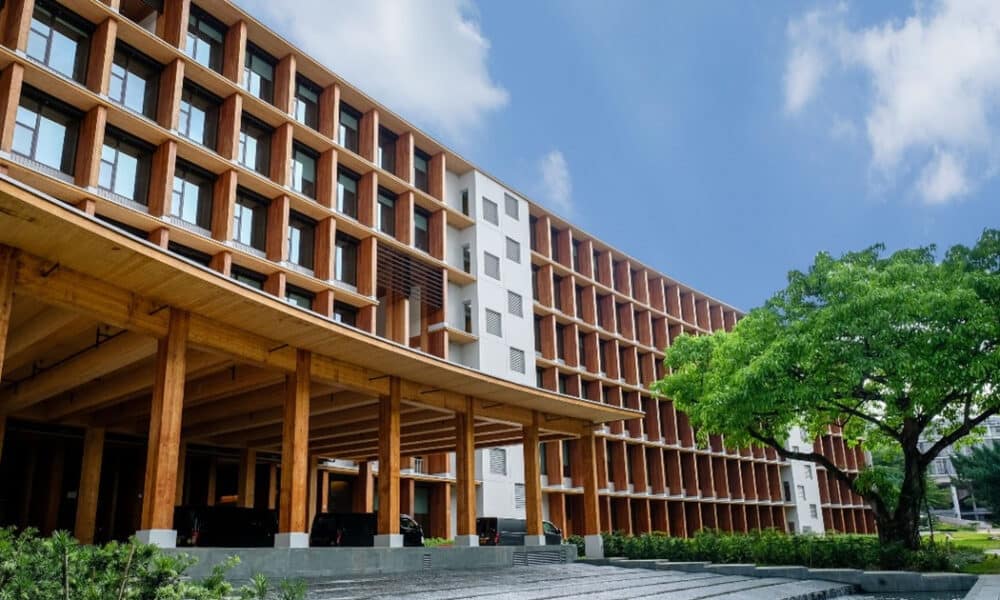SINGAPORE: The Gaia building at Singapore’s Nanyang Technological University (NTU), which opened in May 2023 as Asia’s largest wooden structure, was initially celebrated for its sustainable design and architectural beauty.
However, just over a year later, the S$125 million (US$95.5 million) timber building is facing an unexpected challenge: mould growth.
The 450,000-square-foot Gaia building, constructed with sustainable timber beams and panels, has developed mould on its walls, raising concerns about the suitability of timber for large-scale construction in tropical climates like Singapore’s.
The mould issue highlights the global challenges that timber structures can face, especially in environments with high humidity.
According to Bloomberg, the mould problem at Gaia underscores the difficulties that timber buildings encounter worldwide.
The Gaia building’s timber supplier claims that the structure sequesters over 5,000 tons of CO2, even when accounting for shipping, as trees absorb carbon dioxide during growth.
However, Singapore’s tropical climate, with its high humidity and frequent rainfall, has revealed the limitations of using timber in such environments.
The wood used in Gaia, primarily Austrian spruce processed into mass-engineered timber, is less resistant to mould compared to other species.
In Singapore’s humid conditions, untreated spruce is particularly vulnerable to mould and rot, according to Andrew Wong of the International Wood Culture Society.
Erik L’Heureux, an associate professor of architecture at the National University of Singapore, emphasized that different climates present unique challenges for timber construction.
He noted that in tropical regions, special care is required to prevent issues like mould, while in other climates, such as deserts or freezing environments, timber faces other risks like cracking and splitting.
Singapore has used mass-engineered timber in over 20 projects in the past decade, but it remains unclear if other buildings are experiencing similar issues.
In contrast, Singapore’s colonial shophouses, built with regionally native hardwoods, are naturally resistant to mould.
However, sourcing these traditional hardwoods today is both difficult and costly.
Loh Kee Soon, the lead architect for Gaia at RSP Architects Planners & Engineers, explained that while thicker protective coatings could have mitigated some of the mould issues, his team opted against it due to cost concerns and a desire to showcase the natural wood grain.
Despite its aesthetic appeal, the presence of mould has raised health concerns among staff and students.
While the mould is not expected to affect the building’s structural integrity, NTU has implemented a comprehensive maintenance plan, which includes reapplying sealant to the timber, adjusting air-conditioning settings, and instructing staff to keep windows closed to reduce condensation.
Experts also recommend treating surfaces with bleach, applying thicker coatings, installing dehumidifiers, and running the air-conditioning continuously, although these measures could undermine the building’s sustainability.
Netizens question sustainability of NTU’s Gaia building amid mould concerns
Under Mothership’s Facebook post, netizens have expressed various concerns regarding the mould issue at Nanyang Technological University’s (NTU) Gaia building.
One user questioned whether continuing to use the building is worth it, given the upcoming maintenance and potential health risks to staff and students.
They suggested that if maintenance is not feasible, it might be better to endure a one-time inconvenience of demolition rather than face ongoing issues.

One commenter questioned the logic of using wood in Singapore’s hot and humid climate, suggesting that protective coatings should have been applied to prevent mould.
They pointed out that NTU should have had the resources to implement such measures.

Another netizen proposed that demolishing the building and replacing it with a concrete structure might be a better long-term solution than continually dealing with mould.

Netizens raise concerns over material choices for NTU’s Gaia building
Several netizens focused on the choice of wood for the building, criticizing the decision to use Austrian spruce instead of locally sourced tropical wood that is more resistant to humidity.
One commenter pointed out that using wood from Austria hardly seems sustainable or environmentally friendly when considering the carbon footprint.

Another suggested that the building should have used hardwoods like teak, ebony, or mahogany, which are more resistant to termites and mould.
Further criticism focused on the project’s planning, with some questioning why wood from a cool climate was used in Singapore’s tropical environment.
They speculated that the original committee might have prioritized reducing construction costs, leaving the current management to deal with the consequences.
One commenter expressed disbelief that the project proceeded with wood susceptible to mould, despite the availability of more suitable materials like teak and cedar.
They criticized the $125 million price tag, suggesting it reflects a “lowest cost wins” mentality that overlooks potential long-term costs.

One netizen also raised doubts about the building’s sustainability, questioning whether the cost of treating and preventing mould might become exorbitant over time and ultimately undermine the building’s sustainability claims.


